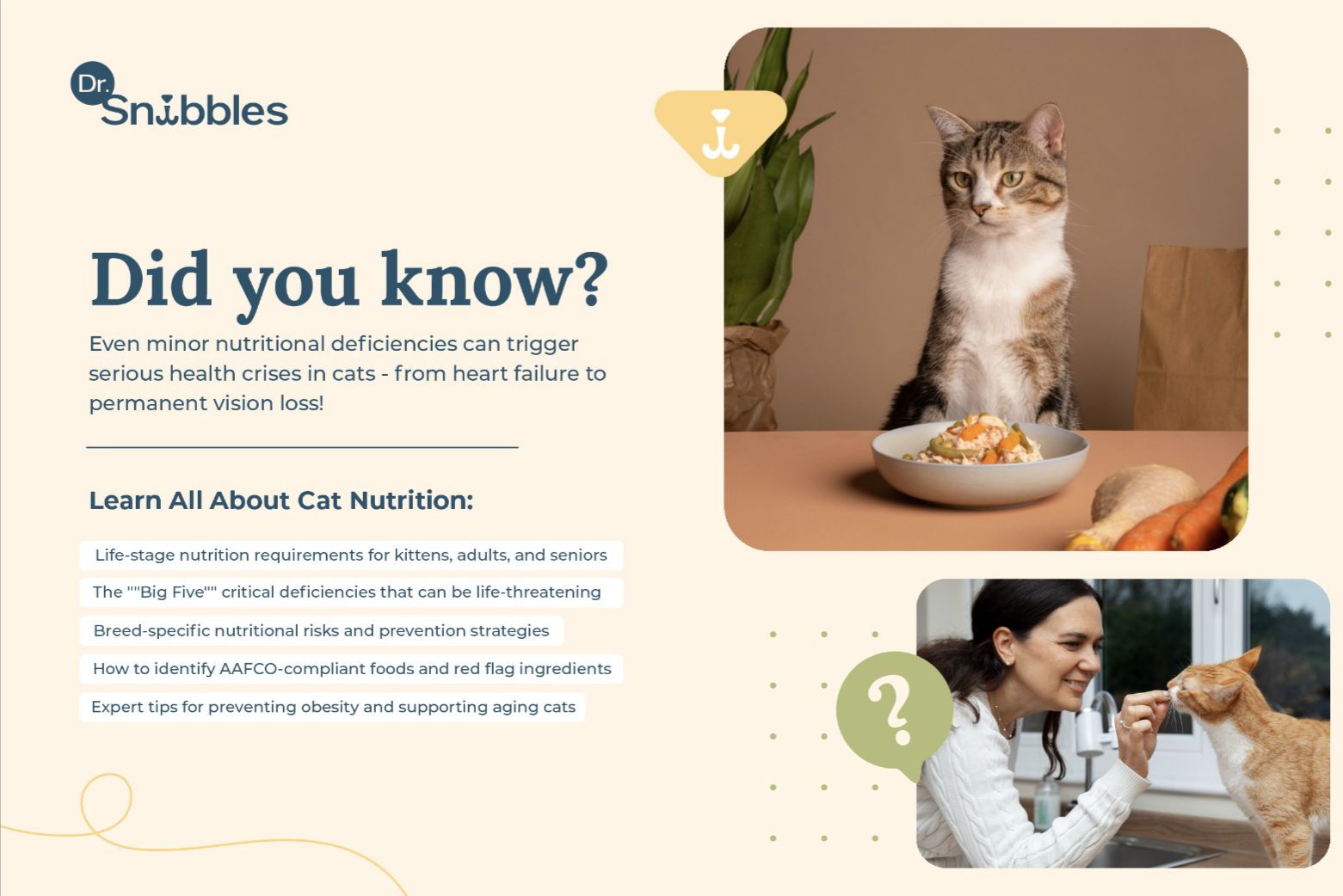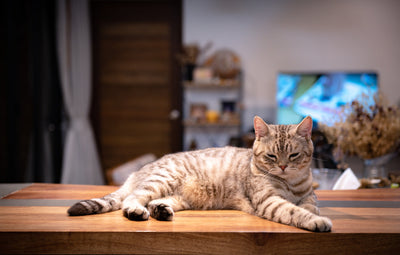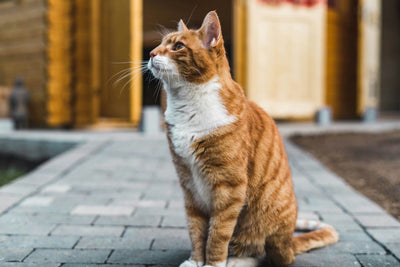Complete Cat Nutrition Guide: Life-Stage Feeding & Breed-Specific Needs
Does your cat really need that expensive "senior formula" food? Are you accidentally harming your kitten with the wrong diet?
As obligate carnivores, cats have evolved unique nutritional requirements that differ dramatically from dogs or humans. According to the National Research Council, cats require specific dietary nutrients that must come primarily from animal-based sources, making proper nutrition crucial for preventing deficiencies and supporting organ function. Understanding these needs isn't just about feeding—it's about unlocking your cat's potential for a longer, healthier life.
The Bottom Line: Getting cat nutrition right from kittenhood through senior years can prevent costly health issues and add quality years to your cat's life. This guide breaks down exactly what your cat needs at every stage.

ON THIS PAGE
Proper cat nutrition isn't just about filling a bowl with kibble. Your cat's dietary requirements change dramatically throughout their life, and getting it wrong can lead to serious health problems that cost thousands in vet bills. This comprehensive guide covers everything you need to know about feeding kittens, adult cats, and seniors, plus breed-specific requirements that could save your cat's life. 💡
📚 Essential Cat Nutrition Basics Every Owner Should Know
Cats are obligate carnivores, meaning they must eat animal-derived protein to survive. Unlike dogs, cats cannot produce certain essential nutrients on their own and must get them from their food.
🐕 vs 🐱 What Makes Cat Nutrition Different from Dogs?
Cats need specific nutrients that dogs can produce naturally:
- ❤️ Taurine: Essential for heart function and vision
- ✨ Arachidonic acid: Critical for skin and coat health
- 👁️ Vitamin A: Must come from animal sources (cats can't convert plant beta-carotene)
- 💪 Higher protein levels: Cats need 26% minimum protein, dogs can manage with 18%
⚠️ Never feed dog food to cats - it lacks these essential nutrients and can cause life-threatening deficiencies.
📈 Cat Nutrition Priorities by Life Stage
Understanding your cat's changing nutritional needs is essential for lifelong health. Each life stage requires specific nutrients to support growth, maintenance, or aging processes.

🐾 Kitten Nutrition (0-12 Months): Building Strong Foundations
Kittens aren't just small cats - they're growing machines with dramatically different nutritional needs. Getting kitten nutrition right sets the foundation for lifelong health. 🏗️
💪 Critical Nutrients for Growing Kittens
Protein Requirements: Kittens need a minimum of 30% protein on a dry matter basis for proper muscle and organ development. 📈 Look for foods with named animal proteins like "chicken" or "salmon" as the first listed ingredient. 🥩
✅ Essential nutrients include:
- 🧈 Higher fat levels for brain development and energy
- 🧠 DHA (omega-3) for neurological development
- 🦴 Balanced calcium and phosphorus ratio for strong bones
- ⚡ Sufficient additional calories to support rapid growth
🚫 Common Kitten Feeding Mistakes to Avoid
🛑 Red flags that harm kitten development:
- ❌ Feeding adult cat food (lacks sufficient growth nutrients)
- 🦴 Over-supplementing calcium (leads to skeletal deformities)
- 📉 Low-protein diets
- 🔄 Switching foods too frequently during growth
💡 Pro tip: Feed kittens multiple small meals spaced out over the day rather than one or two large meals. ⏰
⚖️ Adult Cat Nutrition (1-7 Years): Maintaining Peak Health
Adult cats need precision nutrition to stay healthy without gaining excess weight. This life stage is all about balance and prevention. 🎯
📏 How Much Should Adult Cats Eat Daily?
Most adult cats need:
- 🥫 226gms to 340gms of wet food daily OR
- 🥣 1/4 to 1/2 cup of dry food (depending on calorie density)
- ⏰ Split into 2-3 meals to aid digestion
Key focus areas for adult cats 🎯:
- ⚖️ Weight management to prevent onset of diabetes and liver disease
- 🚽 Urinary health through controlled mineral levels
- 🥩 Quality animal protein to maintain muscle mass
- ❤️ Adequate taurine for heart and eye health
🏠 Preventing Obesity in Indoor Cats
Indoor cats burn 20-30% fewer calories than outdoor cats. 📉 The obesity epidemic affects over 50% of house cats, leading to diabetes, arthritis, and shortened lifespans. ⚠️
💡 Weight management strategies:
- 📏 Measure food portions precisely
- 🥩 Choose high-protein, moderate-fat foods
- 🧸 Provide interactive feeding toys
- ⚖️ Schedule regular weigh-ins
👴🐱 Senior Cat Nutrition (7+ Years): Supporting Aging Bodies
Senior cats face unique challenges that require targeted nutritional support. Many health issues can be prevented or managed through proper senior nutrition. 🩺
👀 Signs Your Senior Cat Needs Diet Changes
Watch for these indicators:
- 😴 Decreased appetite or interest in food
- ⚖️ Weight loss or difficulty maintaining weight
- 🚽 Changes in litter box habits
- 🦴 Reduced activity or mobility
- 🪥 Dull coat or skin issues
🎯 Senior nutrition priorities:
- 🍽️ Enhanced digestibility for changing metabolism
- 🧪 Modified phosphorus levels for kidney support
- 🦴 Joint support through glucosamine and omega-3s
- 😋 Increased palatability to encourage eating
Senior diets with antioxidants and omega-3 fatty acids help maintain appetite and support kidney and joint health. 🧬
🧬 Breed-Specific Cat Nutrition Requirements
Certain cat breeds face unique nutritional vulnerabilities due to their genetic makeup. Knowing your cat's breed-specific needs can prevent serious health problems. 🎯
😸 Persian and Flat-Faced Cat Feeding Tips
Special challenges: Brachycephalic (flat-faced) structure affects eating patterns and makes weight gain easier. 🍽️
💡 Nutrition solutions:
- 🥄 Smaller kibble size for easier eating
- ⚖️ Portion-controlled, high-protein diets
- 📊 Regular weight monitoring
- ⬆️ Elevated food bowls to aid swallowing
🦁❤️ Maine Coon Heart Health and Taurine Needs
Breed risk: Maine Coons are prone to taurine-responsive cardiomyopathy (heart disease). 💔
🎯 Critical requirements:
- ✅ Strictly AAFCO-compliant diets with adequate taurine
- ❌ Avoid homemade meals without veterinary formulation
- 🩺 Regular cardiac screenings
📝 Other breed-specific considerations:
- 🐾 Siamese/Oriental breeds: Extra thiamine sensitivity, avoid raw fish 🐟
- 💪 Burmese cats: Monitor potassium levels, especially during illness 🩺
⚠️ The 5 Most Dangerous Cat Nutritional Deficiencies

| Deficiency | Warning Signs 🚨 | Prevention ✅ |
|---|---|---|
| ❤️ Taurine | Heart murmurs, vision problems, lethargy | AAFCO-compliant diets only |
| 👁️ Vitamin A | Night blindness, poor coat, frequent infections | Include animal liver sources |
| 🧠 Thiamine (B1) | Loss of balance, seizures, neurological issues | Avoid raw fish, proper food storage |
| 🦴 Calcium/Phosphorus | Lameness, fractures, dental problems | Balanced commercial diets |
| ✨ Arachidonic Acid | Dry skin, poor wound healing, dull coat | Animal-based omega-6 sources |
⚠️ Remember: Even seemingly minor nutritional gaps can lead to irreversible damage, from heart failure to permanent vision loss.
🏆 How to Choose Quality Cat Food (AAFCO Guidelines)
Not all cat foods are created equal. Here's how to identify truly nutritious options that meet your cat's needs. 🔍
✅ What to look for on labels:
- 🛡️ AAFCO compliance statement (essential for nutritional adequacy)
- 🥩 Named animal proteins as first listed ingredients (chicken, salmon, turkey)
- 📈 Life-stage appropriate formulations
- 🩺 Veterinary nutritionist involvement in development
🚩 Red Flags in Cat Food Ingredients
⚠️ Avoid these warning signs:
- Generic "meat" or "poultry" without species identification
- "With [protein]" claims (only requires 3% of that protein). For example, package mentioned "with crab/ shrimp meat"
- By-products as primary protein sources
- Excessive plant proteins (corn, wheat, soy, pea)
- No AAFCO statement on packaging
- Lack of labelled specifications of calorie density
💰 Quality matters: Investing in AAFCO-compliant foods with named animal proteins costs less than emergency veterinary bills.
🎯 Key Takeaways for Optimal Cat Nutrition
Start with quality: Choose life-stage appropriate, AAFCO-compliant nutrition from an early stage to prevent long-term health issues.
Monitor your cat's needs: Watch for breed-specific risks and adjust nutrition as your cat ages. Regular weight checks and body condition scoring help maintain optimal health.
Invest in prevention: Quality nutrition costs less than veterinary treatment for nutrition-related diseases like diabetes, heart disease, and kidney problems.
When in doubt, consult professionals: Work with a veterinary nutritionist for cats with special needs, health conditions, or if you're considering homemade diets.
❓ Frequently Asked Questions About Cat Nutrition
💪 How much protein should my cat eat daily?
Adult cats need a minimum of 26% protein on a dry matter basis, but most benefit from 30-40% protein. Kittens require at least 30% protein for proper growth and development. 📈
🔄 When should I switch from kitten to adult cat food?
Most cats should transition to adult food around 12 months of age. Large breeds like Maine Coons may need kitten food until 18 months. Make the switch gradually over 7-10 days. ⏰
❤️🩹 What are the signs of taurine deficiency in cats?
Early signs include lethargy, poor coat quality, and decreased appetite. Advanced deficiency causes heart murmurs, vision problems, and reproductive issues. This is why AAFCO-approved foods are essential. 🛡️
🏠 Do indoor cats need different nutrition than outdoor cats?
Yes, indoor cats typically need 20-30% fewer calories due to lower activity levels. They also benefit from higher fiber content for hairball control and weight management. 🧶
🏅 How can I tell if my cat food meets AAFCO standards?
Look for a statement on the package that reads "formulated to meet AAFCO Cat Food Nutrient Profiles" or "feeding tests using AAFCO procedures substantiate..." This suggests nutritional adequacy. ✅
Proper cat nutrition isn't just about feeding - it's about giving your feline companion the foundation for a long, healthy, and vibrant life. By following these guidelines and staying informed about your cat's changing needs, you're setting them up for lifelong wellness. 🌈
🔗 For more pet care guidance, check out our related articles on [cat weight management], [senior cat health], and [choosing the right veterinarian]. Always consult with your veterinarian before making significant dietary changes.


![What to Feed Your Kitten for Optimal Health [2025]](http://drsnibbles.com/cdn/shop/articles/Cat_Banner_resized_3ed7bb31-0221-42c1-b937-bd7dbd7cdf86.jpg?v=1759400268&width=400)
